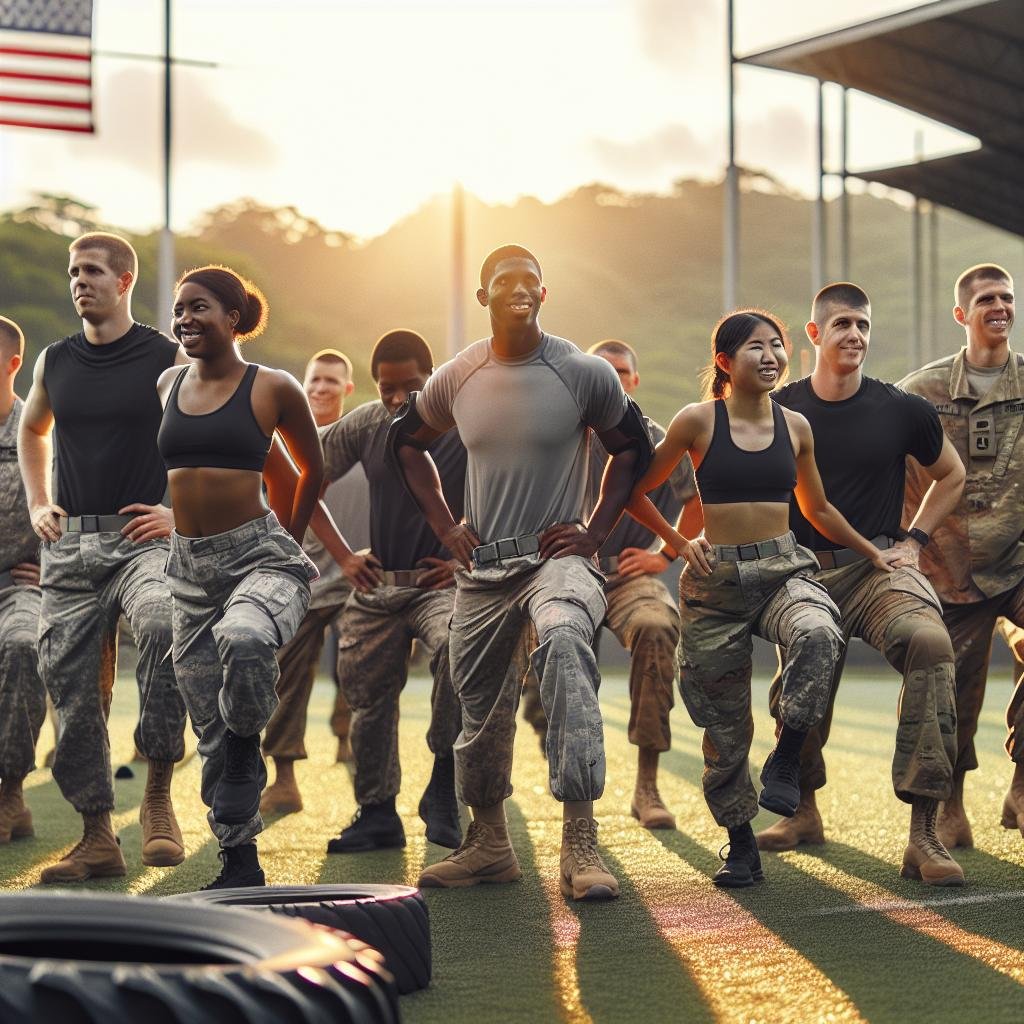
Army Fitness Test Challenge | Ultimate Guide to Success
The U.S. Army is facing a fitness challenge of unprecedented proportions. Over 44,000 active-duty soldiers are currently failing to meet the standards of the Army Combat Fitness Test (ACFT), marking a critical turning point in military physical readiness. This comprehensive guide explores the new fitness standards, why so many soldiers are struggling, and practical strategies for success.
Since the ACFT became the official test of record in October 2022, replacing the decades-old Army Physical Fitness Test, many service members have found themselves unable to adapt to the more demanding requirements. The consequences are significant, affecting both individual careers and overall military readiness.
Understanding the Army Combat Fitness Test Crisis
The statistics paint a concerning picture. According to recent Army data, approximately 8% of the active-duty force—roughly 44,000 soldiers—failed to pass the ACFT during the first year of official implementation. This represents a significant challenge for military leadership trying to maintain combat readiness.
Secretary of the Army Christine Wormuth addressed the situation directly: “We have too many soldiers who are non-deployable or at risk of becoming non-deployable because they’re not meeting our fitness standards.”
The Army faces a difficult balancing act. They must maintain rigorous standards to ensure troops are combat-ready while preventing excessive attrition during a recruitment crisis. This tension between readiness and retention has sparked intense debate within military circles.
The New ACFT: What Changed?
The ACFT represents a radical departure from its predecessor. Unlike the simple push-up, sit-up, and two-mile run format of the old test, the ACFT consists of six challenging events designed to measure various aspects of physical fitness relevant to modern combat situations.
The Six ACFT Events
- 3-Repetition Maximum Deadlift (140-340 pounds)
- Standing Power Throw (4.5-12.5 meters)
- Hand-Release Push-Ups (10-60 repetitions)
- Sprint-Drag-Carry (1:33-3:00 minutes)
- Plank (1:20-3:40 minutes)
- Two-Mile Run (13:30-22:00 minutes)
These events test strength, power, endurance, and cardiovascular fitness in ways that mirror the physical demands of modern warfare. The test requires significant preparation and a more holistic approach to fitness than the previous standard.
Gender-Neutral Standards with Age Categories
After considerable controversy and policy revisions, the Army adopted a gender-neutral scoring system with different standards based on age groups. This approach aims to maintain fairness while acknowledging physiological differences among soldiers.
However, the gender-neutral standards have generated mixed reactions. Some argue they ensure all soldiers meet the same combat-relevant benchmarks, while others contend they disadvantage female service members.
Why Soldiers Are Failing: Root Causes
The high failure rate stems from multiple factors. Understanding these challenges is essential for developing effective solutions.
Insufficient Training Infrastructure
Many units lack adequate equipment and facilities to prepare properly for the test. The ACFT requires specialized equipment like hex bars for deadlifts and medicine balls for power throws—items not readily available at all military installations.
This equipment gap creates a significant disadvantage for soldiers stationed at smaller bases or remote locations. Without proper training tools, preparation becomes exponentially more difficult.
Cultural and Physical Readiness Gaps
The transition from the old test to the ACFT represents a seismic shift in fitness philosophy. Many soldiers trained for decades under the previous system must now develop entirely new physical capabilities.
Sergeant Major of the Army Michael Grinston highlighted this challenge: “We’re transitioning from a culture that focused primarily on aerobic fitness to one that demands a more balanced approach including strength, power, and anaerobic capacity.”
For older soldiers or those with previous injuries, this adaptation process can be particularly challenging. The deadlift component, for instance, requires technical proficiency and strength that wasn’t previously tested.
Nutrition and Recovery Knowledge Deficits
Many service members lack proper education regarding nutrition, recovery, and injury prevention. These knowledge gaps significantly impact performance and increase injury risk during training.
A 2018 study in the Military Medicine journal found that only 38% of surveyed service members demonstrated adequate nutritional knowledge for optimal physical performance.
Success Strategies: Mastering the ACFT
Despite the challenges, many soldiers have successfully adapted to the new standards. Their experiences offer valuable lessons for those still struggling.
Progressive Training Approach
The most successful ACFT preparation programs emphasize gradual progression rather than immediate intensity. This methodical approach reduces injury risk while building the necessary physical capabilities.
- Start with technique mastery before adding significant weight
- Implement periodized training cycles with proper recovery periods
- Focus on progressive overload for strength development
- Incorporate interval training for the run and sprint-drag-carry events
Captain Sarah Johnson, a physical training leader at Fort Bragg, recommends: “Begin deadlift training with perfect form at 50% of your goal weight. Only increase load when technique is flawless. This prevents injuries and builds sustainable strength.”
Targeted Weakness Remediation
Every soldier has different strengths and weaknesses. Identifying and systematically addressing weak areas produces faster overall improvement than generic training programs.
Common weakness patterns include:
- Upper body strength deficits (affecting push-ups and power throw)
- Posterior chain weakness (impacting deadlift performance)
- Core endurance limitations (reducing plank times)
- Anaerobic capacity constraints (hindering sprint-drag-carry times)
Specialist Thomas Rivera shares his experience: “I was failing the deadlift despite hours in the gym. When I specifically addressed my hip mobility and hamstring flexibility, my performance improved dramatically within weeks.”
Nutrition and Recovery Optimization
Physical performance depends heavily on proper fueling and recovery practices. Soldiers succeeding on the ACFT typically prioritize these often-overlooked aspects.
Essential nutrition strategies include:
- Consuming adequate protein (1.6-2.2g per kg of bodyweight daily)
- Timing carbohydrate intake around training sessions
- Maintaining proper hydration status
- Ensuring sufficient micronutrient intake through varied food choices
Recovery practices that enhance performance include:
- Prioritizing 7-9 hours of quality sleep nightly
- Implementing active recovery sessions between intense workouts
- Using mobility work to maintain joint function
- Managing stress through mindfulness and relaxation techniques
The Army’s Response: Policy Adaptations
Facing significant failure rates, Army leadership has implemented several policy adjustments while maintaining the test’s core standards.
Training Support Initiatives
The Army has deployed Master Fitness Trainers to units with high failure rates. These specialists provide technical coaching and develop unit-specific training programs addressing identified weaknesses.
Additionally, the Army has allocated $70 million for equipment distribution to ensure all units have access to the necessary training tools. This investment demonstrates the institutional commitment to helping soldiers succeed.
Remedial Programs and Second Chances
Rather than immediately processing soldiers for separation after test failures, the Army has implemented structured remediation programs. These initiatives provide failing soldiers with specialized training and multiple opportunities to meet standards.
Colonel John Harrison, who oversees ACFT implementation at Fort Hood, explains: “We’re giving soldiers the tools to succeed, not just opportunities to fail. Our remedial program has helped 68% of previously failing soldiers pass the test within three months.”
Future Implications for Military Readiness
The ACFT challenge represents more than just a fitness test transition—it signals a fundamental shift in how the military conceptualizes physical readiness for modern warfare.
Evolution of Combat Physical Requirements
Today’s battlefield demands different physical capabilities than conflicts of previous generations. Modern soldiers must handle heavier equipment, operate in diverse environments, and perform complex physical tasks under extreme stress.
The ACFT’s design reflects these changing requirements. By testing deadlift strength, explosive power, and anaerobic capacity, it better predicts performance in contemporary combat scenarios.
Recruitment and Retention Implications
The Army faces a significant recruitment challenge, missing its 2022 goal by 15,000 soldiers. High ACFT failure rates could potentially exacerbate this problem if not managed carefully.
However, data suggests that units with higher fitness standards actually experience better retention of quality personnel over time. Soldiers who rise to physical challenges often demonstrate greater commitment to their military careers.
Success Story: From Failure to Excellence
Staff Sergeant Maria Cortez exemplifies the potential for adaptation and improvement. After failing her initial ACFT with scores significantly below standards in the deadlift and sprint-drag-carry, she faced potential career consequences after 12 years of service.
“It was devastating. I’d never failed a PT test before, and suddenly my career was at risk,” Cortez recalls. “But it became my motivation to completely transform my approach to fitness.”
Working with a Master Fitness Trainer, Cortez developed a periodized training program focusing on her weaknesses. She addressed nutritional deficiencies, prioritized recovery, and gradually built strength and power.
Six months later, Cortez not only passed the ACFT but scored in the top 10% of her unit. Her success story demonstrates that with proper guidance and dedication, the standards are achievable regardless of starting point.
Practical ACFT Preparation Guide
12-Week Training Template
This simplified template provides a framework for ACFT preparation:
- Weeks 1-4 (Foundation Phase): Focus on technique mastery, general conditioning, and identifying weaknesses
- Weeks 5-8 (Development Phase): Increase training intensity, implement event-specific drills, and address identified weaknesses
- Weeks 9-12 (Performance Phase): Incorporate test-specific workouts, practice complete ACFT simulations, and fine-tune event techniques
Each week should include 3-4 strength sessions, 2-3 conditioning workouts, and 1-2 recovery days. This balanced approach develops all physical qualities needed for the test.
Equipment Alternatives for Limited Resources
Soldiers without access to standard ACFT equipment can use these alternatives:
- Deadlift: Sandbags, water jugs, or heavy backpacks
- Power Throw: Weighted backpacks or sandbags
- Sprint-Drag-Carry: Improvised sleds using tires or weighted duffel bags
Master Sergeant James Wilson advises: “Creativity is key when resources are limited. I’ve seen soldiers excel using nothing but filled water jugs and sandbags for their entire preparation.”
Conclusion: Meeting the Challenge
The Army Combat Fitness Test represents both a significant challenge and an opportunity for the U.S. military. While current failure rates are concerning, the evidence suggests that with proper training approaches, educational support, and policy adjustments, soldiers can successfully adapt to the new standards.
The ACFT’s focus on functional fitness better prepares service members for the physical demands of modern warfare. As the Army continues refining implementation strategies and soldiers develop new training habits, pass rates will likely improve over time.
For individual soldiers facing this challenge, the path forward requires embracing comprehensive fitness development, addressing specific weaknesses, and committing to gradual improvement. With dedication and proper guidance, the standards are achievable for the vast majority of service members.
The ultimate success of the ACFT will be measured not just in pass rates, but in how it transforms the physical culture of the Army and prepares soldiers for the complex demands of 21st-century military operations.


